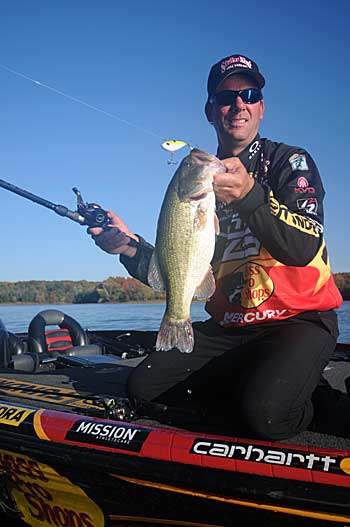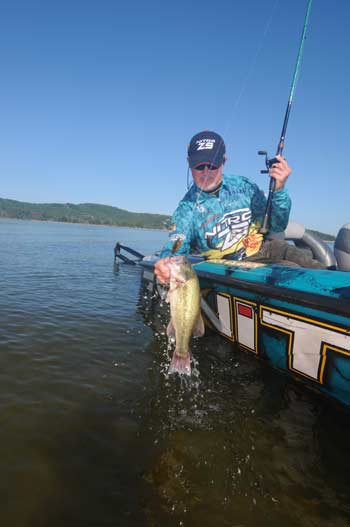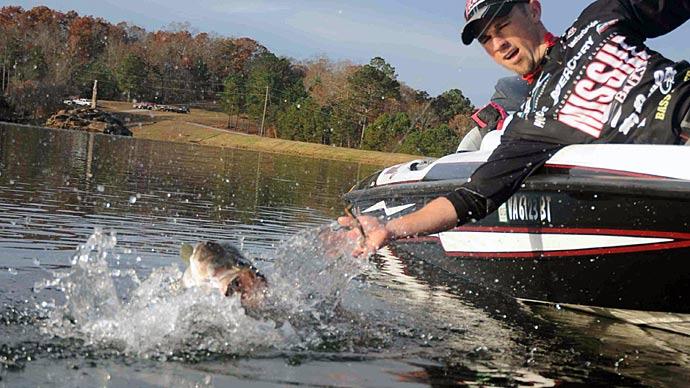
Jigs and plastic worms have always been the old reliables for anglers placing in the money in tournaments throughout the years.
Both of these lures in different styles and sizes continue to pay off in checks for tournament competitors, but some newcomers are getting in on the act, especially for the touring pros facing a wide range of waters and climates across the country. As lure manufacturers keep spinning out new creations, the pros are finding new ways to make money on the tournament trail.
The following Bassmaster Elite Series and Major League Fishing (MLF) pros reveal the lures they have made the most money off of throughout their careers.
Kevin VanDam
The Strike King Red Eye Shad lipless crankbait has become a big moneymaker for this MLF pro. “Since we came out with that lure, it is one of those lures when the conditions are right, and you need a lipless crankbait. There is just not another one to choose," VanDam claims. "I won the Bassmaster Classic with it, and I have had many great tournaments with it. It is an all-season bait for me, but in the springtime, when the water is cold, and the lipless crankbait bite is on in the Southern lakes with grass, there is nothing that comes close to that Red Eye Shad. "
The Michigan pro won the Classic with a Red Eye Shad in the gold sexy pattern and won another tournament in Florida on the chrome sexy shad model. Still, he is usually more concerned about matching the forage than colors when he throws the lipless crankbait. "If I am in East Texas in the spring, I am going to throw crawdad patterns, and when I am fishing in the fall on Guntersville, I am going to be throwing shad patterns," he says.
The 1/2-ounce model is his confidence lure, and he sticks with it for fishing at various depths, even though some anglers would probably switch to a larger or smaller version. "I adjust my line size to make that 1/2-ounce bait run the depth I want," he says. "So if I am fishing a little bit shallower instead of going immediately to that 1/4-ounce bait, I will have 20-pound test on the rod to help the bait run shallower. If I am fishing a deeper flat and yo-yoing in deeper water, I will go down to 10–pound test to make the same 1/2- ounce size go a little deeper."
His most productive retrieve for the lipless crankbait is a stop-and-go presentation. "If I am trying to make the bait run deeper, I will sweep the rod to the side and pump it. That keeps the line lower to the water and helps the bait run deeper." He also likes to yoyo the crankbait, similar to a jig fishing deeper water.
Jason Williamson
This South Carolina pro's money lure is a jig, particularly a Buckeye Lures Mop Jig. "I grew up fishing a jig, and I think that around the country, a jig consistently catches bigger fish more than any other bait," he says. "You can fish it so many ways. You can swim it, flip it, and cast it. It is not just one-dimensional. So day in and day out, if I had a rod that I always want in my rod locker, it would definitely have a jig tied on it."
The touring pro favors the Mop Jig because it has large rubber strands that perform better than jigs with silicone skirts. "I think the Mop Jig is just something the fish don't see much," Williamson says. "The fish see regular silicone jigs a lot." He tips his jig with a Zoom Super Chunk.
Williamson admits the silicone jig works better when he flips to shallow, heavy cover because the Mop Jig is too bulky and falls too slowly. However, the two-time BASS winner makes his money casting to offshore structures, points, and deep brush piles where the Mop Jig excels. “It’s a better bait once you have found the fish," he says. "You can find the school of fish with a deep crankbait or a Carolina rig covering a lot of water. Once I find a school of bass, if I can get them to bite the Mop Jig, I know I have a chance to win.
"It is a slow presentation, however. It is slow ninety-nine percent of the time with a Mop Jig on the bottom. That living rubber has a lot of movement without moving your line or rod. It will sit on the bottom, and that rubber will flare in and out." His most productive retrieve is usually dragging the jig a short distance, then hopping it twice, followed by another drag.
Rick Clunn

In the early days of tournament fishing, Clunn relied on custom-made wood square bill crankbaits to cash a check.
"It amuses me today how everybody gets upset about a $15 bait because back in the late '70s and early '80s, you were paying anywhere from $20 to $75 apiece for those custom wood baits," says Clunn. "Even with the custom-made lures, I would have to buy four or six, and then only two of those six would be what I call Grade A, and then two more would be Grade B, and the other two might not be worth a darn at all." He usually practiced with the Grade B models and only fished the Grade A crankbaits in the tournaments because the custom-made baits were brittle and usually cracked or broke a bill if the lures hit a rock or piece of wood too hard.
Big O’s were the first mass-produced plastic square-bill crankbaits that worked pretty well, according to Clunn. As a result, various plastic square bills have been the top moneymakers for Clunn. "We finally replicated a (plastic) bait identical to those original custom wood baits, yet it was ten times more durable," says Clunn.
A 3.5-inch square bill works best for Clunn when he burns it in off-color water (about 1 foot of visibility). "Very rarely has a square bill produced a winning stringer for me working it slowly," he says. Instead, the four-time Bassmaster Classic champ tries to deflect the lure off logs, stumps, and rocks in the 1- to 6-foot depth range. Most of his money finishes with the square bill occurred during the post-spawn in late spring and early summer. The square bill has also won him some money in fall tournaments.
Edwin Evers
A Texas-rigged beaver-style bait has been a breadwinner for this Oklahoma pro. "I haven't won any tournaments on that bait, but I have won a lot of money with it," he says. "It's just one of those things when it is tough, or I am looking for a bite. I have a lot of confidence when it is tied on the end of my line, and I've got to pitch it somewhere."
The MLF pro rigs the soft plastic bait with a 1/4-ounce weight and 4/0 straight shank hook and pitches it to rocks, grass, laydowns, and stumps. "I must determine if I will get a reaction from the fish by hopping it real hard or just dragging it. I have had some tournaments where I have done well just dragging it slowly along the bottom."
Relying on their money lures hasn't always produced victories for these pros, but they know the baits will perform well enough to deliver high finishes that keep the money rolling into their bank accounts.
BassResource may receive a portion of revenues if you make a purchase using a link above.



